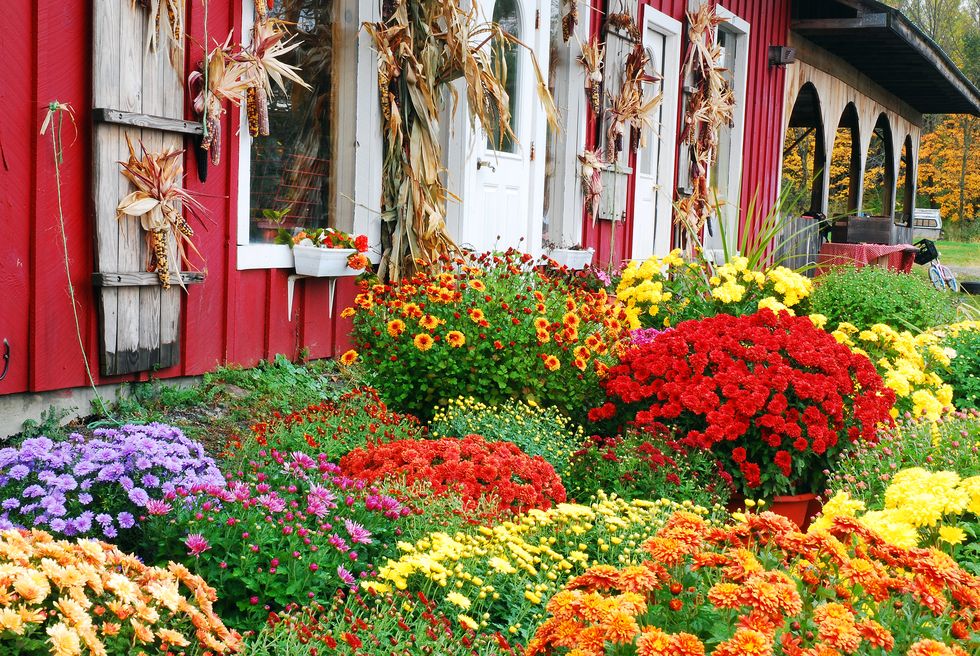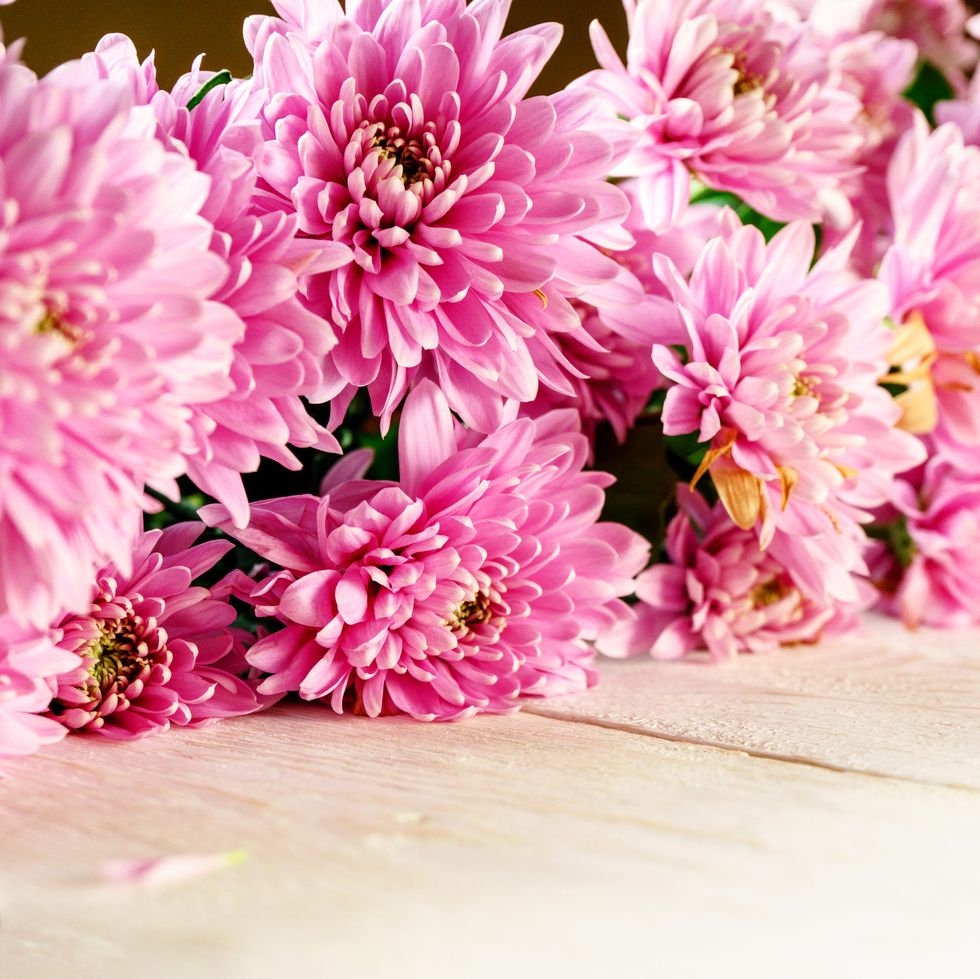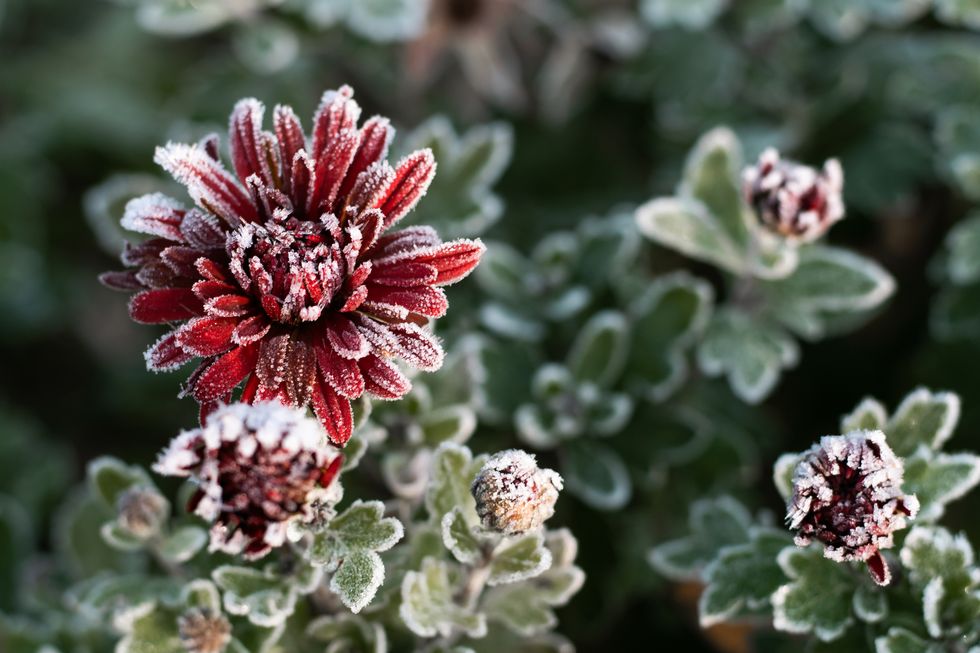Table of Contents
Chrysanthemums, also known as mums, make gorgeous additions to flower beds, hanging baskets and porch pots. In fact, they’re one of the most eye-catching florals for the autumn season, especially since they come in multiple colors. Think red, white, orange, yellow, pink and even burgundy! Plus, they bloom for weeks and can liven up a garden or containers until the winter season begins.
Since all plants and flowers require proper care when it comes to potting, pruning and just staying alive throughout the season, we’re sharing how to grow and care for mums, along with some of the different types you can plant in your garden.
Whether you have a green thumb or not, it’s never too late to learn how to care for plants, including aloe vera, spider plants, pumpkin plants and any other perennial blooms you love. But if you simply want to enjoy mums without the commitment of caring for them long-term, the best time to buy them is at the end of August or the beginning of September, when they’re in full bloom. This way, their enchanting scent and stunning colors will wow you and anyone else who encounters them.
Chrysanthemums 101:
In late summer when other plants call it quits, mums hit their stride. Like poinsettias, they’re photoperiodic, meaning they rely on specific amounts of light to send the signal that it’s time to start putting on a show.
On average, garden mums will not start to set buds until nights last about 10 hours. Blooms follow in six to 10 weeks. Cool temperatures don’t bother mums, either. In fact, chilly weather intensifies colors and keeps blossoms looking fresh until the first hard frost drops the curtain on the gardening year. If you choose early-, mid-, and late-blooming varieties, you will enjoy a full seven weeks of bloom — a brilliant last act for any landscape.
When selecting varieties, there’s a wide range of types to pick from: decorative, daisy and low-growing cushion mums, as well as early-blooming anemones, quills and spiders.
Are Mums Perennials or Annuals?
Though technically perennials, mums are often grown as annuals. If you live where winter can be frigid (USDA Plant Hardiness Zones 3 through 6), go with early-blooming varieties — they’re more likely to come back in subsequent years. Those of you who live south of Zone 6 can push the envelope, opting for varieties that need more time to reach their full potential. When winter looms, apply a mulch of crisscrossed evergreen boughs to help plants navigate the cold weather ahead.
Several years ago, horticulturists at the University of Minnesota developed a new chrysanthemum hybrid described by perennial breeder Neil Anderson, Ph.D., as a “hardy shrub mum.” Dubbed the My Favorite Series, the robust plants were touted as reliably perennial as far north as zone 3b. They have been hard to find the past couple of years but returned to the market this year under a new name, the Mammoth Series.
True to their new designation, these oversized mums can measure 2 to 3 feet tall and 4 to 5 feet across by their third season, with a massive canopy of flowers — up to 5,000 per plant. Monarch butterflies adore these shrubby wonders.
Finally, to increase the odds that your chrysanthemums will survive winter, consider planting them in spring instead of late summer to give root systems ample time to become established.
How to Care for a Potted Mum Plant:
You’ll find that garden mums thrive in containers. Whether they’re placed in a simple clay pot or along the windowsill in a flower box, the right amount of soil, water and sun will help them grow. But keep in mind, repotting mums is important for their health. According to My Garden Life, these plants “tend to get root bound, making it difficult for the soil to retain water.” That’s why repotting is imperative to add more soil and room for the roots to spread.
- Soil: While mums thrive in just about any soil type, they benefit from generous helpings of homemade compost. Dig in a spadeful at planting time and top-dress with more. Soil must be well drained or the plants will rot.
- Sunshine: Mums need full sun. Those planted in full sun bloom more profusely than those in partial shade. An optimal site receives six to eight hours of direct light.
- Water: Shallow-rooted mums dry out quickly. Be sure to water them consistently, especially during dry spells and in fall, when plants store energy for winter survival.
- Pinching Back: If you don’t like the leggy look (who does?), remove the tips of stems early in the season to encourage branching. Repeat the process every two weeks until mid-July. Mums purchased as annuals in late summer do not require this treatment.
Taking Cuttings From Mums:
Creating new plants from your favorite mums is easy, says Galen Goss, executive director of the National Chrysanthemum Society. Simply snip off a 4-inch stem with leaves on it and put it in a pot filled with a soilless medium, such as vermiculite. Keep it moist and outdoors in a bright spot.
After a couple of weeks, repot the cutting (which has sprouted roots) to a small container filled with potting soil. Fertilize once a week. Two to three weeks later, transplant it to the garden and keep fertilizing. You’ll enjoy flowers that very autumn!
Types of Mums:
- For stopping traffic: The spider mum Senkyo Kenshin stands 3½ feet tall. You’ll find that it blooms about 27 reddish-bronze blossoms per plant.
- For brilliant color: Jessica has joyful, bright yellow blossoms. This midseason decorative mum is from the Prophets Series.
- For double duty: An old favorite, French Vanilla has 3½ inch white flowers. Grow in a mixed border or cutting garden.
- For cold climates: Minnautumn is an extremely cold-hardy mum. It’s only 15 inches tall with vivid orange-red flowers.
- For the vase: Carousel is a purple quill mum measuring up to 4 inches across.
How to Winterize Mums:
According to The Old Farmer’s Almanac, mums likely won’t last through the colder months because “mums that are planted late in the growing season are near or at the flowering stage, and they won’t put energy into growing roots to sustain themselves through the winter.” All that energy was already put into blooming. That’s why it’s better to plant them in the spring or fall so the roots come in before the season’s chill. So, after fall, winterize your mums by keeping them unpruned. And for more protection, add four to six inches of mulch after the ground freezes over.
How Do I Care for Mums in My Garden?
- Use shorter cushion mums to carpet a slope. Foot-tall mounds of lush foliage make an attractive ground cover until late summer when colorful flower heads steal the show.
- Start a nursery bed where you can grow your own mums from cuttings. In late summer, transfer the ready-to-bloom plants into the garden to replace tired-looking annuals.
- When a killing frost is predicted, pot up your mums and bring them indoors to adorn the Thanksgiving table.
- Plant taller varieties for use as cut flowers. After cutting, split the stem ends so they can take up water more efficiently.
Are mums poisonous to cats and other pets?
Mums contain a chemical called pyrethrin, which is known to be toxic to cats and dogs. If consumed, they may cause digestive issues and other symptoms like depression, fatigue and seizures.
Are mums deer-resistant?
No, mums are not deer-resistant. While they may not attract deer to your garden, they may still be eaten by the animals if found while foraging near your home.
*additional reporting by Mariah Thomas






